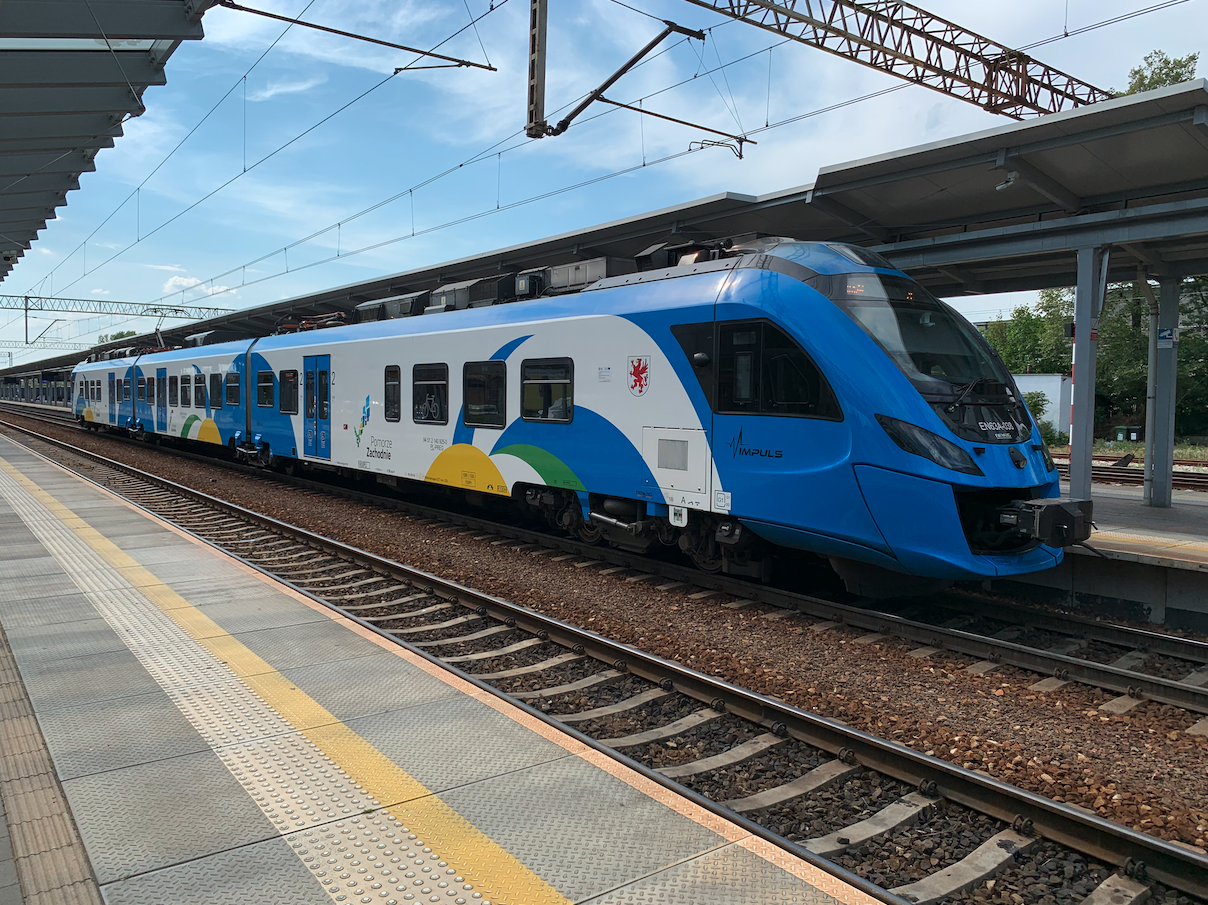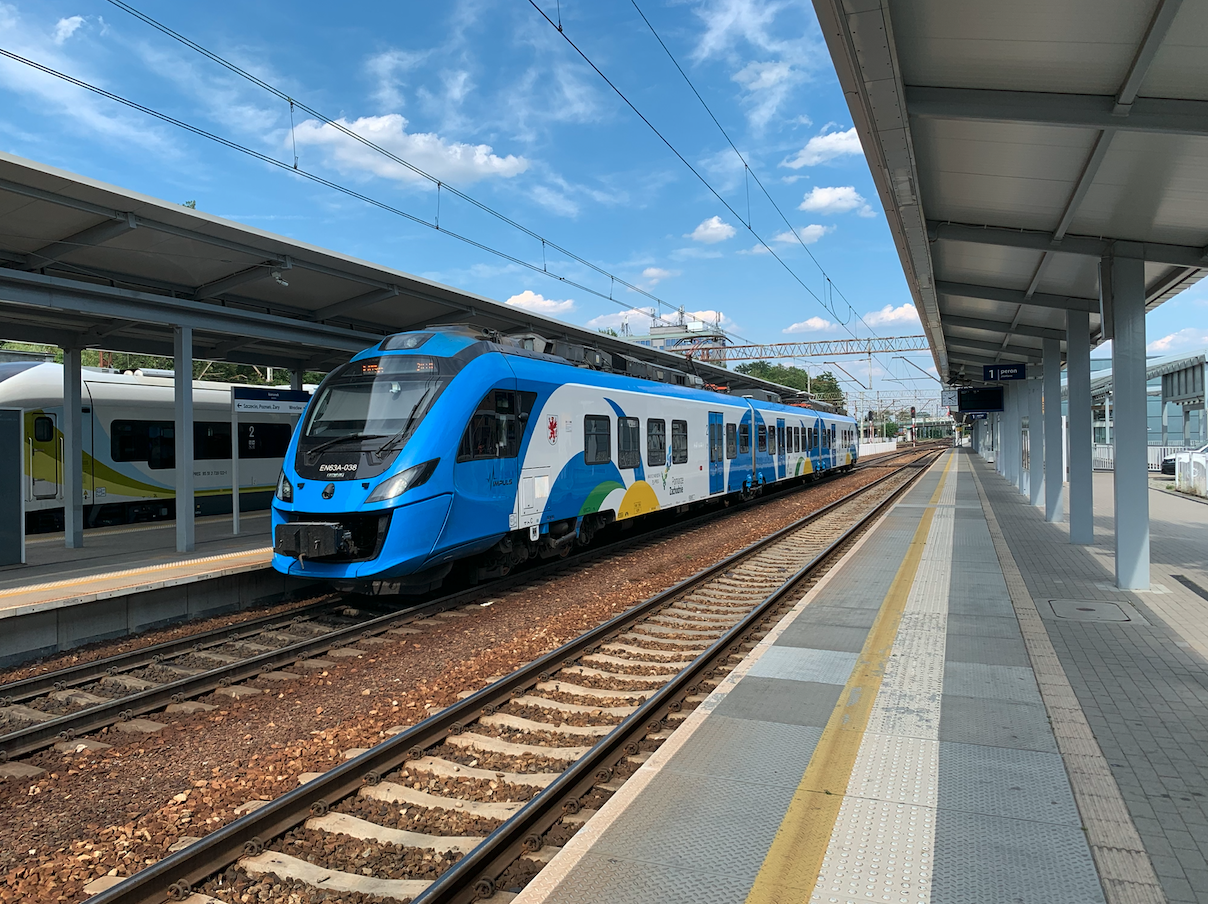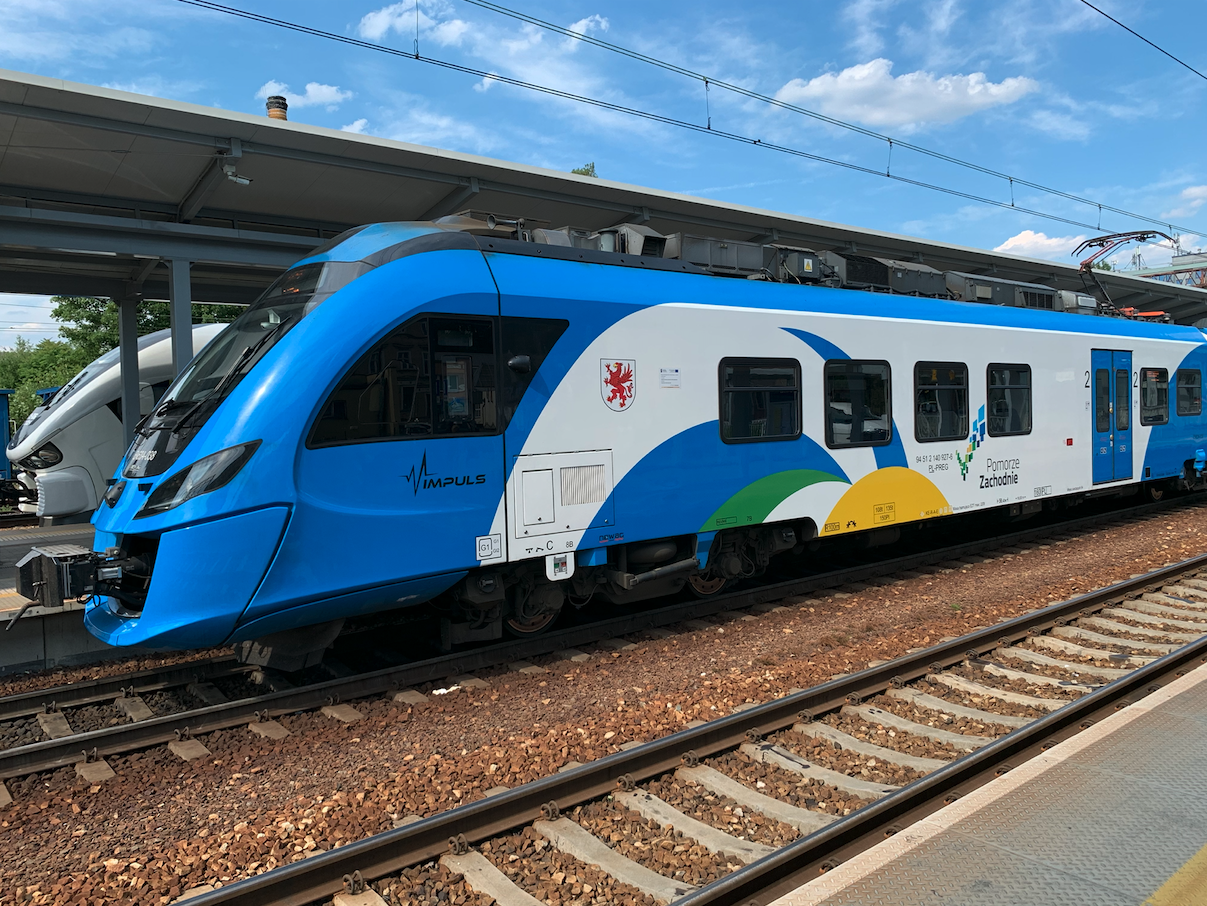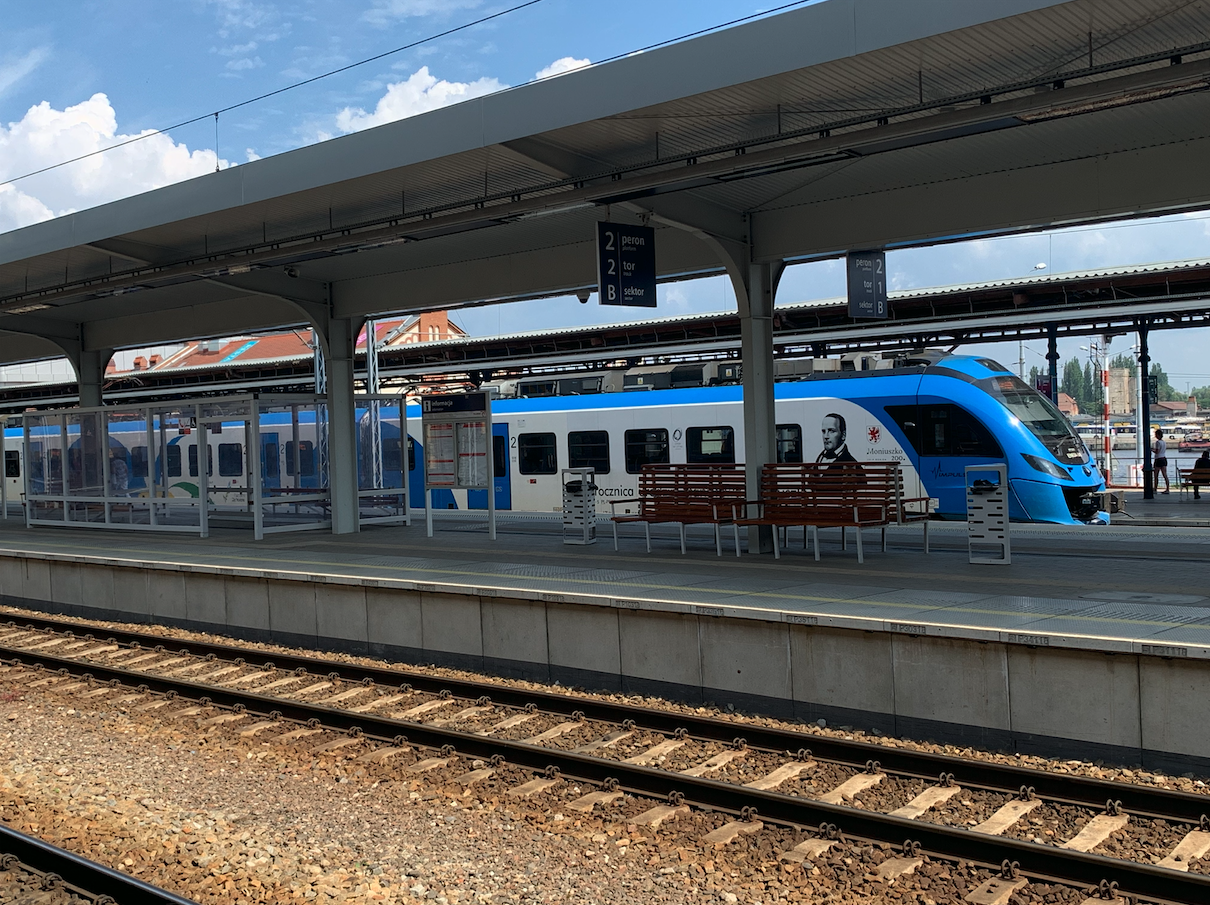Szczecin 2022-08-29
EZT Newag EN63A Impuls.





Description of the photo: EZT EN63A-048 Impulse in veneer - Stanisław Moniuszko on the occasion of the 200th anniversary of the birth of the Great Polish Composer in 2019.
Railways West Pomerania.
The West-Pomeranian Voivodeship is one of the least populated voivodships in Poland. With an area of 22,892 square kilometers, the population is 75 people per square kilometer. Especially the eastern part of the province is sparsely populated. There are municipalities with less than 20 people per square kilometer. This demography influences the development of rail transport.
A major problem of the West Pomeranian Voivodeship is the failure to adapt the current railway network to the current needs. Most of the railway line was inherited by Poland from the former Prussian railway. Their course and technical parameters did not correspond to Poland. Lots of lines had to be closed. As a result, many cities completely lost their railway connections, such as: Człopa, Dobra Nowogrodzkie, Dobrzany, Gościno, Ińsko, Maszewo, Połczyn Zdrój, Płońsko Pyrzyckie, Resko, Skrzydłowo, Stepnica, Świelino and others. It should be remembered that in 1945, hundreds of kilometers of tracks were demolished by mosquitoes and hung up to the CCCP as "trophies". The theft of railway infrastructure as well as plant and machinery and equipment was carried out on a huge scale.
In Poland, many lines have been electrified. Mainly north-south routes. But there are many more lines that are not electrified. Therefore, the Pomeranian region is perfect for trains with bimodal (hybrid) drive.
Railways in Zachodniopomorskie are served by the carrier PolRegio - Zachodniopomorski Zakład in Szczecin, address: Plac Brama Portowa 1, 70-225 Szczecin.
In 2020, it was confirmed that PolRegio S.A. it will then be a company that, with the help of about 70 trains owned by the West Pomeranian self-government, provides railway connections in West Pomerania. Of this number, approximately 40 vehicles are trains built by Newag. On average, around 240 rail connections are operated in the region every day. There are over 1,200 km of railway lines of national and regional importance in the region, along which passenger trains run. Most large and medium-sized cities in the area can be reached by train.
The carrier PolRegio, the plant in Szczecin, maintains the following connections: 340 - Kołobrzeg - Białogard - Szczecinek - Poznań. 360 - Szczecin - Cross - Poznań. 365 - Szczecin - Kalisz Pomorski - Wałcz - Piła. 366 - Szczecin - Gryfino - Kostrzyn - Zielona Góra. 368 - Szczecin - Angermünde - Berlin. 369 - Szczecin - Lübeck. 370 - Szczecin - Kamień Pomorski / Świnoujście. 375 - Szczecin - Goleniów - Kołobrzeg. 380 - Szczecin - Koszalin - Słupsk. 382 - Koszalin - Kołobrzeg. 382A - Koszalin - Mielno. 383 - Szczecinek - Słupsk. 384 - Sławno - Darłowo. 385 - Szczecin - Szczecinek. 385A - Szczecinek - Chojnice. A1 - Szczecin - Goleniów. A2 - Szczecin - Stargard.
Newag Impuls.
On November 4, 2013, the West Pomeranian Voivodeship signed an agreement with Newag for the delivery of 12 4-car EZT Impuls vehicles for the Świnoujście - Szczecin - Poznań and Szczecin - Słupsk routes. The first three copies were delivered in December 2013. The last one was delivered in March 2015. In September 2016, more trains were ordered, including 12 3-car trains. The first new trains started operating in May 2017. In July 2017, seven more Impuls trains were ordered: 3 3-car EMU and 4 4-car EMU. Deliveries of Impuls trains were completed in September 2018. As part of this order, the Zachodnio-Pomorskie Province also purchased the Impuls train simulator. In the period 2013-2018, a total of 42 Newag Impuls trains were purchased.
Hybrid trains - Bimodal trains.
The first bimodal train in the world was built in Poland by the Newag company in Nowy Sącz. Initially, the project envisaged the construction of a separate vehicle that was to be combined with any EMU that was produced in Poland. Basically, the new vehicle was a diesel locomotive, but there were some significant differences. The new vehicle was to have one mechanic's cabin. The vehicle was to be based on two two-axle bogies. The box was to contain the internal combustion engine that powered the generator. The generated electricity was to drive four electric motors located at the axles of the bogies. The shape of the new vehicle was to be almost identical to the front part of the EZT wagon. The project was to be implemented by April 2019.
However, Newag engineers developed an even more modern design. In the existing box of the first and the last car of the EMU train, it was possible to place one internal combustion engine, which moves the power generator, and the electric current supplies the same electric motors installed at the axles of the bogies. As a result, the EMU under the traction network kept the train speed at 160 km / h. However, on non-electrified lines, a triple train (electric transmission) reaches a running speed of 120 km / h. This is a sufficient speed, because almost all non-electrified routes do not allow driving at a speed of over 140 km / h.
For the West Pomeranian Voivodeship, on October 28, 2020, the first contract for the purchase of hybrid trains was signed. The contract was implemented very quickly, because Newag had been secretly working on this type of hybrid vehicle for several months. Newag has overtaken all competitors in the world and has become a world market leader.
On January 24, 2021, the first and second hybrid trains Impuls 2 "Bursztynowy" and "Zielony" set off on the routes. These trains were the pride of the area. These are the first vehicles of this type in Poland and in the world. Initially, the trains ran on the Szczecin - Kołobrzeg and Szczecin - Szczecinek route. The next route was the Szczecin - Goleniów Airport. The vehicles can also run on routes in Germany, where there is a different electric traction.
On July 14, 2021, the third hybrid vehicle, Impuls 2 "Blue", was presented in Kołobrzeg. In 2021, the local government of West Pomerania announced that it would buy a total of 12 hybrid Impuls 2 units. For 12 vehicles, the West Pomeranian Province paid PLN 295.2 million gross. In June 2022, the eighth unit of the order (EN63H-008) was delivered and at the same time the first in a new painting scheme referring to the European flag.
At the same time, it put up for sale two SZT Link vehicles that were not yet 10 years old. Also on sale were 3 EZT EN57 vehicles (EN57AL-1515, EN57AL-1570, EN57AL-1557) and two PCS type 223M vehicles of the SA139 series and one diesel rail bus of the Pesa type 212M series number SZT Link SA109.
These purchases and sales were aimed at standardizing the operated rolling stock. According to the voivodeship self-government, the current rolling stock covers most of the transport needs. Hybrids will make the transport offer more flexible and allow you to combine some double routes into one. The aspect of environmental protection is also important. Reduction of pollutant emissions - hybrid vehicles on electrified sections do not use combustion engines.
The new vehicles will allow for better and more flexible satisfaction of the growing transport needs on non-electrified railway lines in Western Pomerania. Replacing the two-car trains (SA139 and SA109) with three-car hybrids increases the transport capacity and travel comfort. There are more seats in the carriages and more space for frequently transported bicycles. The total number of trains will not change, but the number of rolling stock for servicing non-electrified sections will increase from 15 to 24. The accessibility of railways for people with disabilities has increased.
Impuls 2 Hybryda 36WEh = EN63H.
Impulse 2 hybrid has the manufacturer's designation 36WEh, and the railroad designation is EN63H. The producer is Newag, which has a plant in Nowy Sącz. Impulse 2 hybrid are vehicles that can move with the use of internal combustion engines or alternatively using the 3 kV overhead contact line. The action engines have a power of 1,600 kW. The vehicle moves at a speed of 160 km / h under electric traction and 120 km / h on internal combustion engines. The diesel drive is used in the sections without the overhead contact line. Impuls 2 36WEh are equipped with traction motors that can be powered from the mains by means of a current collector, as well as by a Newag-Pack drive unit, which consists of an internal combustion engine (meeting the "Stage 3B" exhaust emission standard) and a power generator. You can easily change the way the electric motors are powered and continue driving.
The vehicles have three carriages. The vehicles have 150 seats (including 8 tiltable ones) and 160 standing places. The vehicles are equipped with toilets in a closed system with access for the disabled. There is space on board for the transport of 10 bicycles and two wheelchairs. The vehicles are air-conditioned, equipped with wireless internet, intercom network enabling communication with the driver, fire alarm, monitoring. There are USB chargers and electrical sockets next to the seats. There are also special technical sockets for connecting, for example, a washer or a vacuum cleaner. Each vehicle is equipped with a defibrillator, pull-out steps and loading ramps for trolleys. The vehicles are adapted to all platform heights. In the middle of the three-section vehicle there is a toilet adapted to the use of wheelchair users, equipped with a hand dryer, a changing table for children, alarm signaling. The vehicle is equipped with an electronic passenger information system (LCD monitors, LED boards), a sound system and a passenger counting system.
Data T-T 36WEh = EN63H.
Length 59.30 m, width 2.84 m. Height 4.21 m. Weight 119 500 kg. Top speed 160 km / h for electric traction. Maximum speed 120 km / h on internal combustion engines. Electric motor power 1,600 kW (4 x 400 kW). Two diesel engines, 2 x 390 kW. The price of one vehicle is approximately PLN 25.5 million (2020).
Written by Karol Placha Hetman
